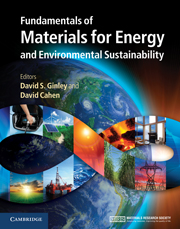Book contents
- Frontmatter
- Contents
- Contributors
- Preface
- Acknowledgments
- Part 1 Energy and the environment: the global landscape
- Part 2 Nonrenewable energy sources
- Part 3 Renewable energy sources
- 17 Solar energy overview
- 18 Direct solar energy conversion with photovoltaic devices
- 19 Future concepts for photovoltaic energy conversion
- 20 Concentrating and multijunction photovoltaics
- 21 Concentrating solar thermal power
- 22 Solar thermoelectrics: direct solar thermal energy conversion
- 23 Off-grid solar in the developing world
- 24 Principles of photosynthesis
- 25 Biofuels and biomaterials from microbes
- 26 Biofuels from cellulosic biomass via aqueous processing
- 27 Artificial photosynthesis for solar energy conversion
- 28 Engineering natural photosynthesis
- 29 Geothermal and ocean energy
- 30 Wind energy
- Part 4 Transportation
- Part 5 Energy efficiency
- Part 6 Energy storage, high-penetration renewables, and grid stabilization
- Summary
- Appendix A Thermodynamics
- Appendix B Electrochemistry
- Appendix C Units
- Index
- References
22 - Solar thermoelectrics: direct solar thermal energy conversion
from Part 3 - Renewable energy sources
Published online by Cambridge University Press: 05 June 2012
- Frontmatter
- Contents
- Contributors
- Preface
- Acknowledgments
- Part 1 Energy and the environment: the global landscape
- Part 2 Nonrenewable energy sources
- Part 3 Renewable energy sources
- 17 Solar energy overview
- 18 Direct solar energy conversion with photovoltaic devices
- 19 Future concepts for photovoltaic energy conversion
- 20 Concentrating and multijunction photovoltaics
- 21 Concentrating solar thermal power
- 22 Solar thermoelectrics: direct solar thermal energy conversion
- 23 Off-grid solar in the developing world
- 24 Principles of photosynthesis
- 25 Biofuels and biomaterials from microbes
- 26 Biofuels from cellulosic biomass via aqueous processing
- 27 Artificial photosynthesis for solar energy conversion
- 28 Engineering natural photosynthesis
- 29 Geothermal and ocean energy
- 30 Wind energy
- Part 4 Transportation
- Part 5 Energy efficiency
- Part 6 Energy storage, high-penetration renewables, and grid stabilization
- Summary
- Appendix A Thermodynamics
- Appendix B Electrochemistry
- Appendix C Units
- Index
- References
Summary
Focus
The Sun's radiation can be modeled as a 6,000-K blackbody radiator. Whereas photovoltaics (PV) can convert the part of the Sun's spectrum to electrical energy, over 40% of that spectrum, namely, the infrared (IR) range, is lost as heat. In solar thermoelectrics (TE), the thermal energy from the IR range is converted directly into electricity. Therefore, a solar PV–TE hybrid system would have access to the entire spectrum of the Sun.
Synopsis
With respect to solar energy conversion, PV devices utilize the UV region, whereas TE devices utilize the IR region (which is waste heat with respect to the PV devices) to generate electricity. In a solar PV–TE hybrid system, a high-efficiency solar collector would turn the sunlight (from the IR spectrum) into heat that would then be transformed by TE devices into usable electricity. In addition, the solar thermal energy could be stored in a thermal bath, or TE devices could be used to charge batteries that could then provide electricity when the Sun was not shining. Such a TE system would need to operate at around 1,000 K (~700 °C), and the materials would need to exhibit high ZT values around this temperature.
- Type
- Chapter
- Information
- Publisher: Cambridge University PressPrint publication year: 2011
References
- 2
- Cited by



